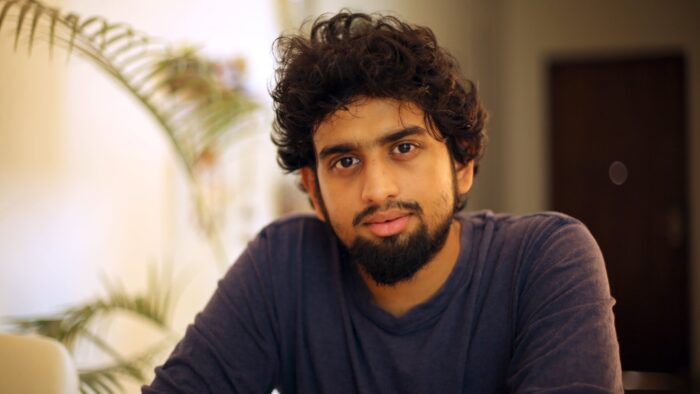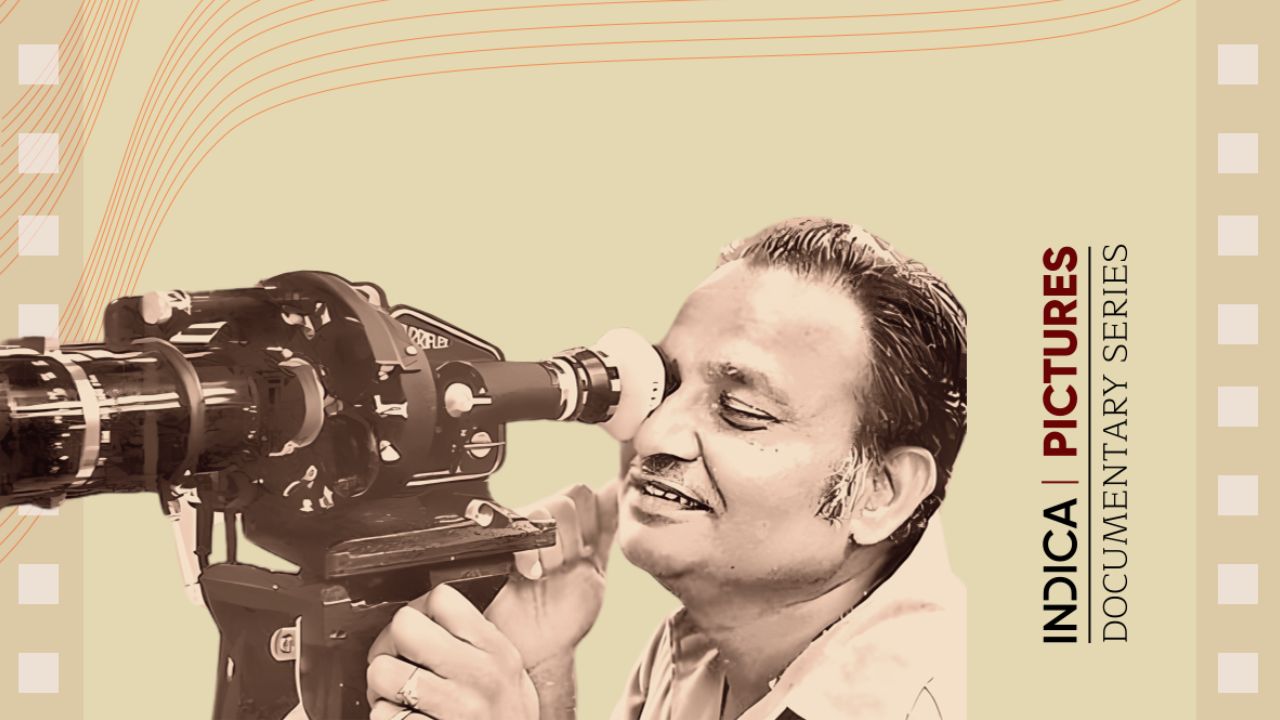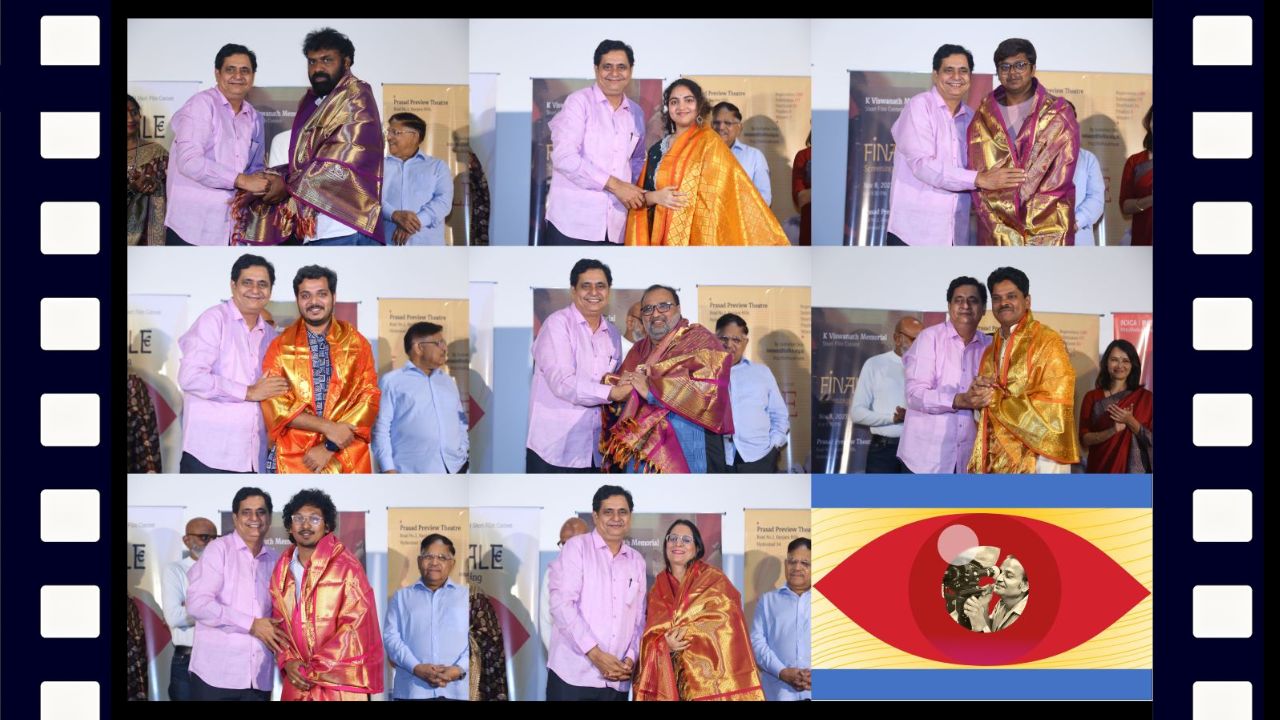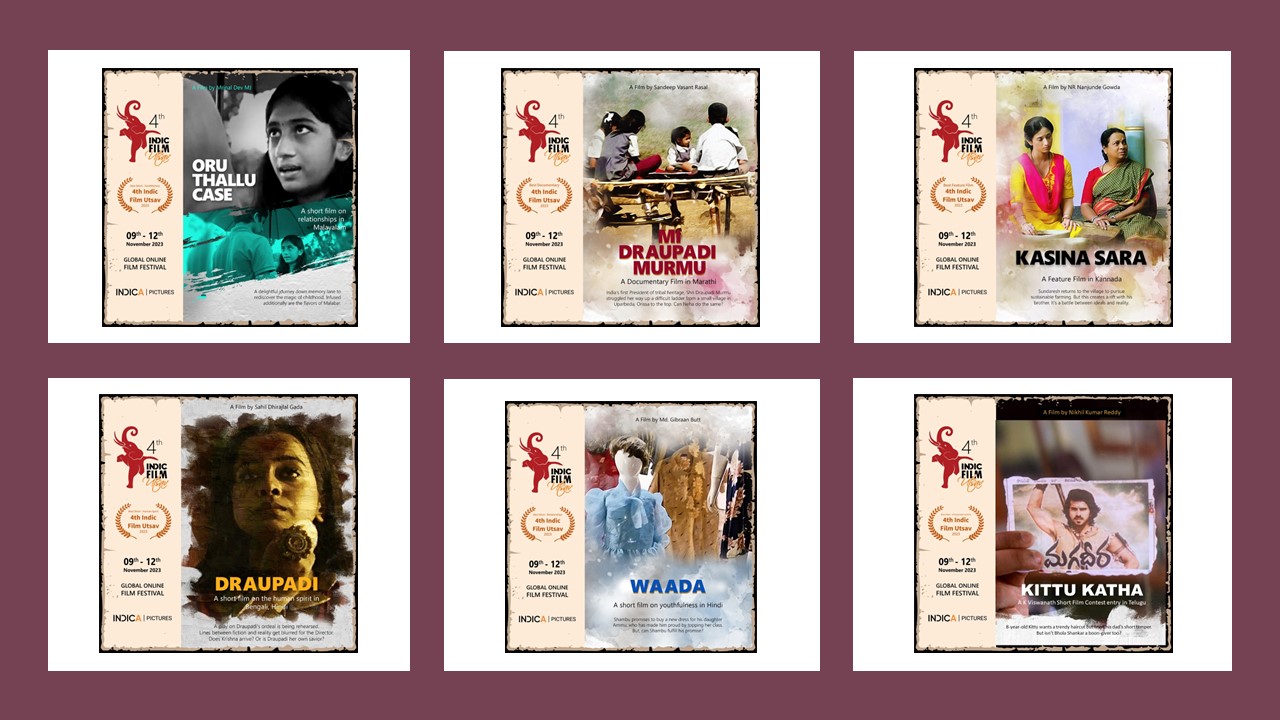Sriram Raja’s award-winning documentary film ‘The Flowers and The Gemstones’ is focussed on a family of floral garland makers in a village near Kanyakumari. The film turns to the family for narrating the story of the garland, which travels the miles of time across mythology, Maharajas, and modern times. In the process, the artisans become retellers of their own art, journey, the painstaking process involved in their art, and their family tradition. Team Indica Pictures interacted with the filmmaker on his journey to Thovalai, his experiences with the family of garland makers and nuances of his own film-craft.

Floral diversity, fragrance, family and faith intermingle in your work. What led you to the subject of garland-making dedicated to temple life in a Kanyakumari village for this marvelous documentary?
The best part of my childhood was in Kanyakumari before we shifted to Chennai, where I completed my high school and college. During the bus-travel to Trivandrum, one can see Thovalai, the village, approaching. The flower market in Thovalai is a busy one. When the bus stops at Thovalai, flower vendors would bring in baskets full of colourful flowers. For the rest of the journey, the whole bus would smell of flowers. One day, when I was at my film school (FTII, Pune), I was thinking about my childhood and was looking at the images of places in and around Kanyakumari. I was reading about Thovalai and landed on a very interesting photo story on a blog page. One of the photographs was that of Manikkamalai Muthumperumal, the garland artisan featured in the film. I was fascinated by the garland he was holding in it. It was nothing like the types of garlands I’ve seen. I wanted to find him, but there were no coordinates of the family. I did my best to find his contact, and after a few months, I was successful. When we finally met, I got to know so much about the life of garland artisans and the family’s connection with the temple in Thiruvananthapuram. However, what I saw and experienced was much more than just stories. The people were warm. There was a beautiful inter-communal relationship in the village. I met flower farmers who were Hindus and Christians. The flowers plucked before sunrise are sold in the market. The garlands are then sent to Hindu temples as well as Churches; to marriage functions, felicitation functions, funeral processions, political rallies and more. In today’s times, the village life there stands as a true symbol of the rich cultural diversity we should practice and be proud of.
Why did you want this story to reach the Indian audience?
To be honest, I started making the film to feel good. I wanted to take a camera to the place where I have the best memories and show my friends and acquaintances how beautiful the place is. That was the starting point, but once you set out, cinema takes you on a ride. While shooting, I was experiencing something way more special than revisiting my childhood. I heard many stories and many versions of the same story. There is a folk legend attached to the garland. It also has a connection with the age-old craft of coconut leaf weaving, a connection with the kings, also a connection with a temple that is almost 2000 years old. You go deeper and it stretches all the way till the Puranas. There, I witnessed the true power of oral tradition. These stories have kept the tradition alive. I wanted to give the audience the same experience I had when I was there in the village. It feels good when someone writes back after watching the film saying they felt as if they were there in the village while watching it.
I don’t see the audience as local and global. We all watch films from every part of the world. We should also be able to tell our stories to others in a cinematic language they understand.
Tell us about your stay for shooting the film, the duration of your stay with the family of garland makers and the impact it had on you, surrounding the idea of a “family”.
My wife Deyali and I started working together from our film school days. She is the cinematographer for this film and it was my desire to take her to my childhood place. She knows me and my taste well and that level of comfort helped this film. For technical reasons like copying data and charging the equipment, we had to take a room in Nagercoil, a town near Thovalai village. Every day, we would leave before sunrise for the village. The market opens early, at around 4 am. We wanted to capture the busy hours. Films Division, the producer of the film, had commissioned a 26-minute film. We were shooting a lot but had to keep in mind the duration of the film. We had to judiciously shoot things to tell multiple things in a short duration. But we also wanted the pace of the film to be relaxing and not dense.
We would interview the family when they had the time. When they worked, we would hang around shooting or just observing them. Now and then, the elders would take time out to teach the kids the craft. The kids show interest in learning it. When there are big orders, the whole family assembles and everybody works together. It is quite a sight. We felt good to see Muthumperumal and his wife Tamilarasi working exactly like us. Our professions are different but the spirit of partnership was the same. We learnt a lot about work-life balance from them. We were shooting at their place on Deyali’s birthday and when they knew about it, they prepared a feast for us – the tastiest food we’ve ever had. The time we spent with the family is one of our favourite memories. After finishing the shoot in Thovalai, we followed the garland to Thiruvananthapuram. Permission was denied to shoot inside the temple, but we shot the facade, the palace and the market.
We also shot at Kanyakumari beach. There were so many other things we couldn’t include in the film, like the Floriculture Research Station in the village, for duration reasons.

The process of making garlands involves art, aesthetic, colour, design, and devotion. Tell us about aspects of the craft that left you speechless when you were documenting the process.
The Manikkamalai garland is a combination of math, science and creativity. But an important part is the concentration and precision that come with practice. The trickiest part: if one picks a white oleander flower instead of red by mistake, the design goes for a toss. Beginners make the garland after they sketch it on a grid paper. Experienced artisans have the design in their mind. Their hands and brain work in sync. Once, I asked Muthumperumal something while he was making the garland. He was silent for a while and then he stopped weaving to reply to my question. Before he got back to work, he said he doesn’t weave the garland while talking. A wrong flower means opening up
the entire garland and starting again with new flowers. The respect and devotion they have towards their own work is truly inspiring. Garlands would stay just till the flowers start rotting. I asked them how they keep themselves motivated knowing none of their creations would last forever. He said that is precisely the thing that motivates him. He believes nothing stays forever, what matters is how good it is long as it stays. Once it perishes, it is time for a new one to be made. To answer the question, the patience and their philosophy towards life and the craft is what left me speechless when we were documenting the process.
Members of this family are powerful story tellers. Then, their belief in ‘pauranic’ tales is woven into garlands and daily life. What did you learn about retelling and listening in the process of working on this film?
I witnessed the power of oral tradition while making this film. Not just pauranic tales, but also folklore, anecdotes about how the garland got its name, how the village turned into a valley of flowers etc. Everything is preserved through oral tradition. It is passed down generations orally in the form of stories. In the film, there is a moment where Tamilarasi tells us how stories help children respect the flowers. She tells them stories about how gods live in the pollen inside the petals. The kids stop disrespecting the flowers when a devotional story is attached to it. There is an annual temple festival in the village called ‘Soorasamharam’. If you happen to visit the village, you can listen to multiple versions of the same mythological story from different people in the village. But the moral of the story remains the same. Everyone interprets it in their own way. It is the same for the garland craft too. There is no copyright or ownership over the technique. Anyone is free to learn it, practice it and interpret it in their own way. The garland craft has survived till now, thanks to this.
Tell us about other aspects of temple life that interest you as a filmmaker.
When one starts reading more, one realises that the temples in India are more than just places of worship. It is a community gathering space where performances of the arts take place. During the rule of kings, temples used to be the place where important decisions were discussed. Some temples are libraries that store important manuscripts. One can find the best sculptures and the finest mural art displayed in our ancient temples. I learned from an archaeologist that the earliest method of conserving a water body is by sanctifying it. A story gets attached to a lake or a pond and a temple is built near them so that people don’t exploit or destroy the waterbody. Not just the arts and history, the microeconomics around temples fascinates me. Every temple has a busy market attached to its complex. Many small businesses are dependent on the temples, the flower garland shops, for example.
One can’t also ignore the political side. In history, every faith community that came to power has had their strong influence on places of worship. The spaces transformed based on who the patrons were. But one thing that binds all of it together is the devotion of people who go to temples to pray. Temples are beautiful places and they make me really curious but I must say I am also not over-sentimental or judgemental about it.
You have been able to comprehensively show the intergenerational interactions in craftsmanship -- as they live within the family of garland-makers. How, according to you, do they enrich the narrative of this art and craft?
Everyone in the family is a skilled garland artisan but not everyone is a full time garland maker. Muthumperumal’s daughter Vanitha runs a computer education center in the village. She makes garlands when she is not working. The grand children have to go to schools, but they learn the craft after their homework time. The other daughter and son-in-law are skilled artisans. Their children are learning the craft. They all assemble when there is a big order. I realised that every member in the family is proud of the fact that it has been passed down generations. They don’t want to break the chain and are happy to practice it. In the film, we just see the family. Their world is much bigger. Muthumperumal and family voluntarily conduct training workshops in different parts of India. Their students in many places are still practising the craft. They even conduct an annual Manikkamalai competition to award the best garland artisan. The family takes all possible efforts to keep the craft alive.
Your advice to aspiring/upcoming filmmakers on building collaboration and partnerships for filmmaking:
I am just starting out and not sure if I can advise others, but I can share from my experience. Be it fiction or non-fiction, I believe it is very important for the filmmaker to have a personal connection with the subject. One won’t give up when there is a strong feeling inside to tell the story. The other important thing: getting the right people in the team. For me, it is not about how talented they are. It is about how welcoming, accommodating and flexible they are. All these without the skill and expertise won’t help either. Getting the right mix of talent and like-mindedness makes even a simple idea shine. After building the right team and orienting them to your vision, it is important to trust them and let them do their work. And pay them on time.
What are you currently working on?
After completing ‘The Flowers and The Gemstones’, I was commissioned by the Films Division to make a short documentary on the subject of Child Sexual Abuse. The film is now complete. I also write and direct fiction. In 2018, I wrote and directed my first feature film ‘Half songs’. I am now developing my second feature film. We are also preparing for my wife Deyali’s first Bengali feature film which I am producing. We are also shooting a feature- length documentary film.
What do you like reading or watching during the process of working on a project?
It depends on whether I am working on a fiction or non-fiction film. More than watching reference films, I enjoy reading or watching interviews given by filmmakers, both Indian and international. I feel it is important to know about the challenges they faced, the realisations they had when dealing with a similar kind of film. The interviews by the makers of ‘Honeyland’ is a good example. It is a wonderful documentary and the interviews are equally inspiring.
You value the Indic Film Utsav because:
For curating a great lineup of films and being kind enough to include our short documentary in that. We were thrilled when Indic Film Utsav chose to award our film the ‘Best Documentary Film- Special mention’ in 2020. It was the lockdown time and the flower business was terribly hit by the pandemic. Thanks to the cash award, we could share it with the family of garland artisans. Indic Film Utsav was kind to invite me last year to join other panelists for a discussion on filmmaking.
If you were given a bunch of five different stories to show in a single production of 25 minutes, what would they be on?
For some reason, food and music are the two things that first came to my mind when I read the question. I am also very interested in heritage sites and ancient art.
What are your points of focus at the film-editing desk and phase?
Editing was my specialisation at the film school. I began working as an editor before starting to write and direct films. That could be a reason why I am economical while shooting. It may not be a good practice but I start getting a sense of whether the moment I am filming would find its way into the film or not. Sometimes, moments that I felt were insignificant while shooting would eventually become an important part in the edit. While shooting, some special moments happen and I try to remember them. Those are the first bits I access when I sit to edit. I tend to not look at the master-structure when I start editing. I look at the exciting bits in the footage and interesting sounds that got captured. When you find two or more pieces that can go together well, other pieces start falling into place automatically. It takes a long time for the edit to start breathing. Thanks to the training as an editor, I am quite patient to wait for that moment to arrive. Everything deserves its own time and there is no point rushing into anything. Once you start seeing the story in it, the process usually happens quicker.
What subjects and themes in documentary filmmaking would you like to explore in the coming years?
There are subjects that I get attracted to. It is also important for me to feel that I fit into the subject I choose. There should be a strong feeling in me to make the film. Even if it is a small film, I am going to live with it for quite some time and it will become part of my life. I don’t want to approach anything casually or take my creations for granted. I may transform as a person and my perspective towards things may change from time to time, but I can’t disown my creations. It is a record of what I believed in at that point of time. The only thing I want to continue doing is approach every subject with utmost honesty. I believe subjects would choose me and not the other way.




